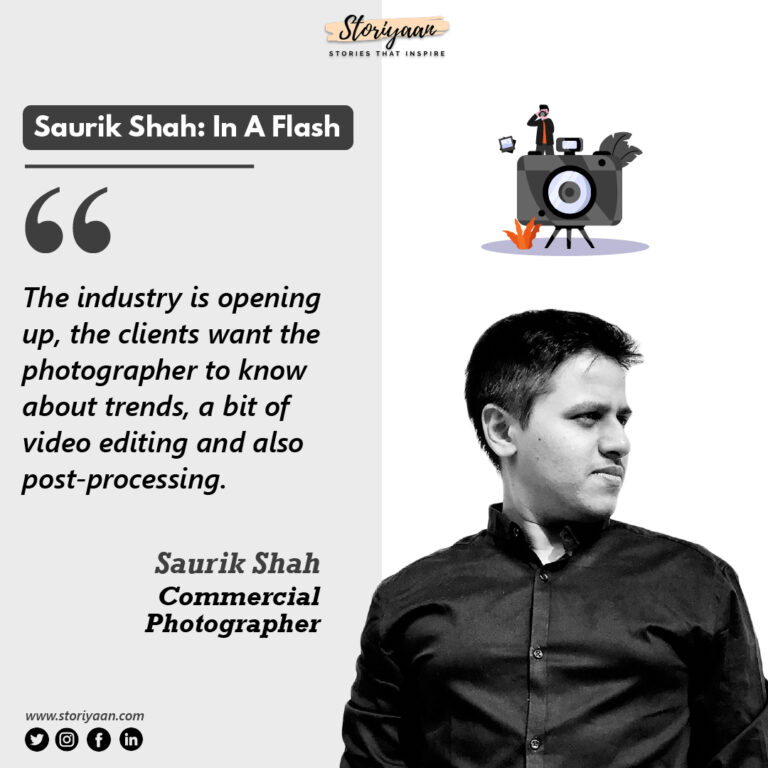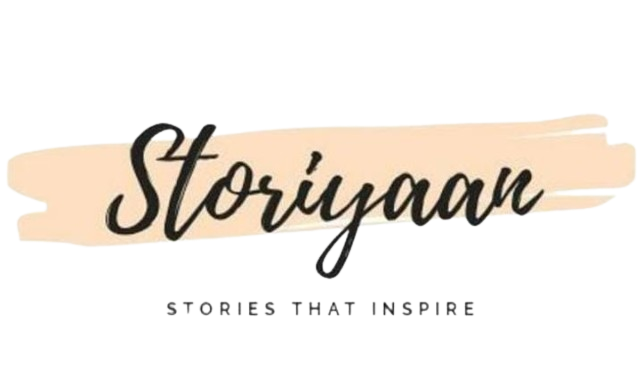“Photography keeps me sane.” Saurik Shah a photographer by profession says. Acknowledging photography as a story he flunks to put into words, Saurik’s path to success was never an easy one. He started this journey as a hobby but never anticipated it to turn into his passion, and soon, profession. With a daring attitude and optimistic glance, Saurik gave his passion a shot and is now a full time photographer working with renowned brands like Sugar cosmetics. To know more about his intriguing journey to the top, follow Storiyaan and read below!

Saurik Shah: Capturing Memories in A Flash
Interview
Questions and answers
To this day, a profession removed from what people call the mainstream careers like that of a doctor or engineer is regarded with uncertainty by most people. Did you ever have to face something like that when you first expressed your desire to pursue photography?
Yes, after completing my BMS, I was asked to pursue an MBA due to all the peer pressure around, but my family supported me with my decision to study photography professionally which I’m very grateful for.
Tell us about your fondest memory of the first camera you ever used and the impact it had on you.
My encounter with my 1st camera was an accident. Neither I had any background in art, nor anyone from my family. When our house was under renovation for 4 months, we did not have hands-on entertainment to attend to. Owing to this, I was able to get my hands on the first DSLR (The Canon 1000D). I surfed a lot of websites on how to take an image and learned the process of quality image-making during those 4 months and fell in love with photography.
Does commercial photography differ from the genre of photography you prefer to practice?
They sure do differ. Commercial Photography is quite directional and specific, the client already has an estimate on what the final image will look like, there is no room for much creativity which is bland.
What according to you makes your pieces stand out?
The images below, the sense of lighting and highlighting branding in these images makes it attractive, also the variation of lighting makes it look so dramatic and interesting, giving me and my pieces an advantage.
After the demise of your father, you had to join your family business and photography had to take a backseat. Can you elucidate us through that experience?
It was a classic situation where one is doing sales and making money out of it but there is no happiness, it’s empty. Our business is of tangible products, and photography is an intangible product. I could experience both the world and understand the idea of how competition works.
In art, there is no pricing or market rate, you have to match whereas the product or competitive markets is always revolving around pricing.
When you initially started on this journey, what were some of the hurdles and challenges that were thrown your way?
The biggest challenge I felt was of guidance and recognition because the market of commercial arts in India is quite unorganised, there is no ‘naukri.com’ for creatives, one has to start understanding what they excel at, sharpen their saw and create a portfolio which is made by them. It does take time to get recognised.
You have worked for a host of companies in the e-commerce, creative and advertising spaces. Can you share with the budding photographers among our readers some tips they can use for product photography?
Creating your niche and understanding more about your relationship partners associated with the field will give a headstart. One should also spend time doing personal projects and work, which is not commissioned, this will help one learn more about themselves and what they can keep doing for the rest of their life without getting paid or recognised.
Share with us one of the clientele experiences that caused a major change in the way you perceived the industry to be.
With every client I meet, I discover a lot about how the field and profession work. I would like to share my experience with Sugar cosmetics for whom I have been working for a long time now. The brand has grown multi foods from where we had started, the way a brand is aesthetically designed to make you feel and click on the add to cart button is interesting, the images we shoot have a purpose, the color theory has logic. Nothing is random or a coincidence when you work for a brand that has set a good vision for its visual aesthetics.
What were some of the most significant lessons that you learnt about the industry through experience and trial and error over time?
Nothing is a waste of time if you know how to take experience out of it.
Not all clients are interested in budget or only the art side, one has to see what they really want and how they can get it done.
The industry is opening up, the clients want the photographer to know a little bit about trends, a bit of video and also post-processing.
Be clear in your communication and how much you can execute, be real with your commitments.
What would be your advice to the budding photographers of our generation?
Focus on the art of seeing, not on the equipment.
Do more with less, do not compare someone’s end with your beginning or ongoing journey.
Understand why you like an image or any colour specifically.
Most importantly, chase the light. Whenever you see a pattern, an interesting colour when the light hits it, take an image. These rules really help me and I’m certain that they will help others as well.
Quick 5
1.The greatest bane for photographers: ever-growing Tech and AI in software.
2.The camera you are currently using: Canon Eos R5
3.The camera you are currently using: Canon Eos R5
4.You’re favourite time-pass: Constant analysis of whatever is happening around.
5.One secret skill/hobby that you possess:

